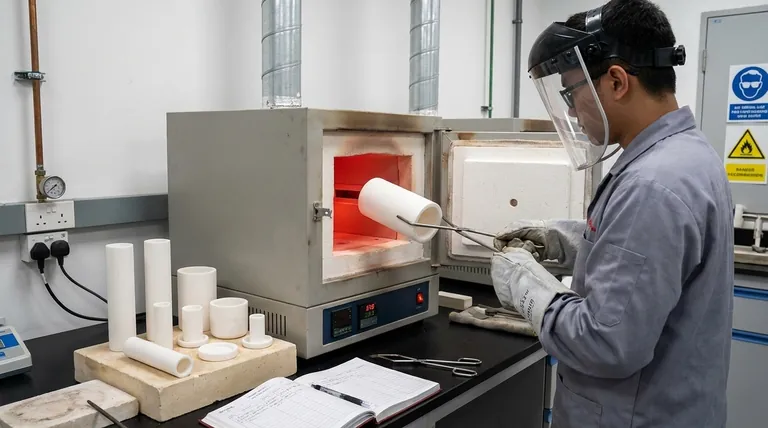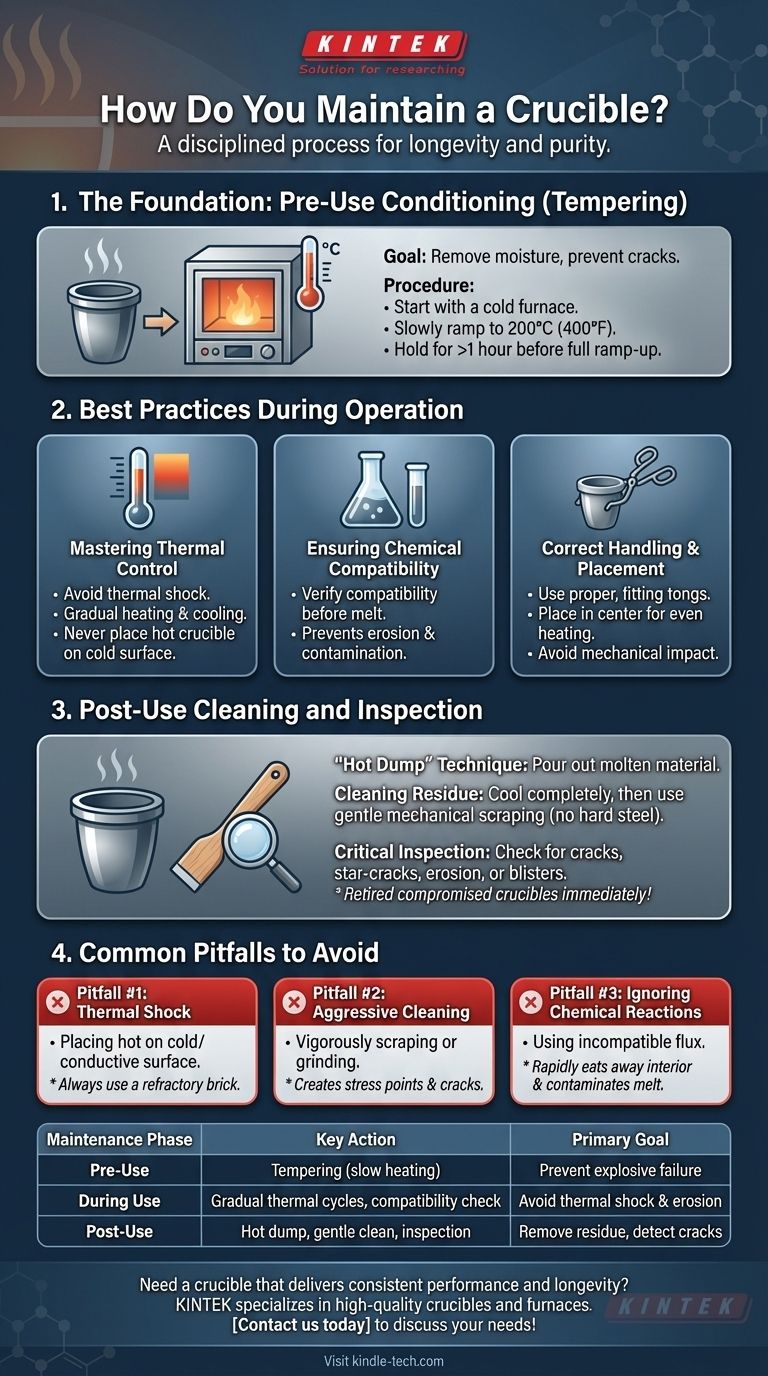Proper crucible maintenance is a disciplined process, not a simple cleaning task. It centers on preventing two primary forms of failure: thermal shock from rapid temperature changes and chemical degradation from incompatible materials. The core activities involve careful pre-use conditioning, controlled heating and cooling cycles, and meticulous post-use inspection and cleaning.
The ultimate goal of crucible maintenance is not merely to clean it, but to preserve its structural and chemical integrity. Viewing your crucible as a precision instrument, rather than just a container, is the key to maximizing its lifespan and ensuring the purity of your work.

The Foundation: Pre-Use Conditioning (Tempering)
Before a new crucible is ever used for a melt, it must be properly conditioned. This initial step is critical for removing residual moisture from the manufacturing process and relieving internal stresses.
Why Tempering is Non-Negotiable
A new crucible contains microscopic pockets of moisture. If heated too quickly, this moisture turns to steam and expands, causing cracks or even explosive failure. Tempering gently drives this moisture out.
A Standard Tempering Procedure
Place the new, empty crucible in a cold furnace. Slowly ramp the temperature to around 200°C (approx. 400°F) and hold it there for at least an hour. Afterward, you can proceed with a slow ramp-up to your working temperature.
Best Practices During Operation
How you use the crucible is the most significant factor in its lifespan. Careful, consistent operation is the best form of maintenance.
Mastering Thermal Control
The leading cause of crucible failure is thermal shock. Never place a cold crucible into a red-hot furnace, and never place a hot crucible on a cold, conductive surface. Always ensure gradual heating and cooling.
Ensuring Chemical Compatibility
A crucible must be chemically inert to the material it holds. Using an incompatible material can cause the crucible to erode, contaminating your melt and weakening the crucible's structure. Always verify material compatibility before a melt.
Correct Handling and Placement
Use properly fitting tongs that grip the crucible firmly without pinching. Place the crucible in the center of the furnace to ensure even heating. Avoid dropping materials into it, as the mechanical impact can cause fractures.
Post-Use Cleaning and Inspection
Cleaning should be done with the goal of removing residue without damaging the crucible's interior surface.
The "Hot Dump" Technique
Whenever possible, pour out all molten material at the end of a session. Allowing a "heel" to solidify inside places significant stress on the crucible as it cools and contracts.
Methods for Cleaning Residue
For any remaining dross or residue, it is often best to allow the crucible to cool completely. Gentle mechanical scraping with a wooden or soft metal tool is preferred. Avoid using hardened steel tools that can gouge the surface.
The Critical Inspection Step
After every use, inspect the crucible for signs of wear. Look for cracks, star-cracks on the bottom, or areas where the surface appears eroded or blistered. A compromised crucible is a safety hazard and should be retired immediately.
Common Pitfalls to Avoid
Understanding what not to do is as important as knowing the correct procedures. These common mistakes are responsible for the vast majority of premature crucible failures.
Pitfall #1: The Dangers of Thermal Shock
This cannot be overstated. Placing a hot crucible onto a concrete floor or a steel table will almost certainly destroy it. Always place it on a dedicated ceramic block or refractory brick to cool.
Pitfall #2: Aggressive Cleaning
Vigorously scraping or grinding the interior of a crucible creates scratches. These small imperfections become stress points during the next heating cycle and can easily develop into full-blown cracks.
Pitfall #3: Ignoring Chemical Reactions
Using an aggressive flux that is not compatible with your crucible material will rapidly eat away at the interior wall. This not only ruins the crucible but can introduce significant impurities into your melt.
Matching Maintenance to Your Goal
Your specific maintenance routine should be guided by the crucible material and your primary objective.
- If your primary focus is longevity: Prioritize slow, even heating and cooling cycles above all else to prevent the stresses that cause cracks.
- If your primary focus is melt purity: Be meticulous about pre-use tempering and verify chemical compatibility to avoid any leaching from the crucible walls.
- If your primary focus is operational safety: Make post-use visual inspection a non-negotiable step to identify and retire any crucible with signs of cracking or degradation.
Treating your crucible with procedural discipline is the single most effective way to guarantee safe operation, pure results, and a long service life.
Summary Table:
| Maintenance Phase | Key Action | Primary Goal |
|---|---|---|
| Pre-Use | Tempering (slow heating to remove moisture) | Prevent explosive failure from steam |
| During Use | Gradual heating/cooling; chemical compatibility | Avoid thermal shock and erosion |
| Post-Use | Hot dump, gentle cleaning, visual inspection | Remove residue and detect cracks |
Need a crucible that delivers consistent performance and longevity? Proper maintenance starts with the right equipment. KINTEK specializes in high-quality lab crucibles and furnaces designed for precise thermal control and chemical resistance. Our experts can help you select the perfect crucible for your specific application, ensuring maximum safety, purity, and lifespan. Contact us today to discuss your laboratory needs and optimize your melting processes!
Visual Guide

Related Products
- Engineering Advanced Fine Ceramics Alumina Al2O3 Crucible With Lid Cylindrical Laboratory Crucible
- High Purity Pure Graphite Crucible for Evaporation
- Alumina Al2O3 Ceramic Crucible Semicircle Boat with Lid for Engineering Advanced Fine Ceramics
- Arc-Shaped Alumina Ceramic Crucible High Temperature Resistant for Engineering Advanced Fine Ceramics
- High Purity Pure Graphite Crucible for Electron Beam Evaporation
People Also Ask
- What temperature can alumina crucible withstand? A Guide to High-Temperature Stability and Safety
- What precautions should be taken when using a crucible? Essential Steps for Safety and Accuracy
- How is a crucible used in the crucible? Unpacking Arthur Miller's Powerful Metaphor
- What needs to be checked before using a crucible? A Guide to Safe and Effective High-Temperature Work
- What are the safety precautions of a crucible? Protect Your Lab from Thermal Shock and Hazards



















